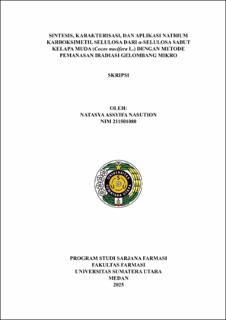Sintesis, Karakterisasi, dan Aplikasi Natrium CMC dari α-Selulosa Sabut Kelapa Muda (Cocos nucifera L.) dengan Metode Pemanasan Iradiasi Gelombang Mikro
Synthesis, Characterization, And Applications Of Sodium Carboxymethyl Cellulose From α-Cellulose Young Coconut Coir (Cocos Nucifera L.) Using Microwave Irradiation Heating Method

Date
2025Author
Nasution, Natasya Assyifa
Advisor(s)
Laila, Lia
Yuliasmi, Sri
Metadata
Show full item recordAbstract
Background: Cellulose is an important component with significant potential in various industrial applications, including as a raw material for pharmaceutical products. Young coconut husk (Cocos nucifera L.) contains a high cellulose content (43.44%), making it an attractive source for cellulose isolation. One of the widely used derivatives of cellulose is sodium carboxymethyl cellulose (Na-CMC), which functions as a gelling agent and can be utilized in various gel formulation applications.
Objective: This study aims to isolate α-cellulose from young coconut husk using a microwave irradiation heating method, as well as to evaluate the efficiency and quality of the isolation results, focusing on the application of Na-CMC as a gelling agent to produce gel formulations that meet standards.
Methods: The isolation process was carried out through three stages: liquefaction, delignification, and bleaching using 5% H2O2 at 500 W power with variations in bleaching time (4, 8, 10) minutes. After isolation, α-cellulose was synthesized into Na-CMC and characterized and then evaluated for its suitability as a gelling agent in gel preparations.
Results: Optimal treatment was obtained with α-cellulose yield of 22.4% at 10 minutes bleaching time. The physicochemical characteristics of isolated α-cellulose showed good quality with DS 0.9 and confirmed by SEM and FT-IR analysis. The viscosity of the gel preparation produced from Na-CMC young coconut fiber, which is 13,953.25 ± 373.97 cP is lower than the viscosity of commercial gel preparations which reached 19,393 ± 119.3 cP. However, this viscosity value is still categorized as meeting the requirements for gel preparations.
Conclusion: The microwave irradiation method is effective in enhancing the efficiency and quality of α-cellulose isolation from young coconut husk. The application of Na-CMC as a gelling agent derived from α-cellulose demonstrates potential in producing gel formulations that meet industry standards.
Keywords: α-Cellulose, young coconut coir, Cocos nucifera L., microwave irradiation, carboxymethyl cellulose, gelling agent.
Collections
- Undergraduate Theses [1833]
